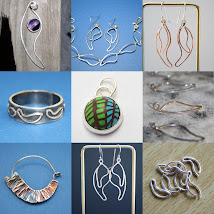
This tutorial describes how I converted glass from a sherry bottle into pieces resembling sea or beach glass, to be used for jewellery making. The bottle was a blue Harveys Bristol Cream sherry bottle.

I used this rock tumbler, which I usually use for sanding polymer clay beads. (You'll find advice on that application, from Desiree McCrorey,
here). The tumbler is sold as a child’s rock tumbler, and is predominantly made from plastic. Mine was purchased from the
Science Museum Shop. Another, similar toy is
here. For tumbling rocks the machine needs to run for several days, and I suspect that it really makes too much noise to be left on all night without disturbing the neighbours. Fortunately, less time is required for tumbling glass, this task can be achieved during waking hours.

The tumbler was supplied with several packets of abrasive grit for use with rocks. I used the coarsest grade for tumbling my bottle glass.
Here are the steps involved in the process:
1. Empty the bottle and rinse it out with water

2. Put on safety glasses and gloves (I used leather gardening gloves)
3. Wrap the bottle in a tea towel that you don't mind getting torn.

4. Take the wrapped bottle outdoors, together with a household hammer
5. Find a suitably hard surface, hold the bottle neck (still wearing gloves and eye protection) and use the hammer to smash the bottle inside the towel. I found that the edge of my concrete doorstep was a suitable surface, and that the hammer worked best when applied to the shoulder of the bottle. The hammer bounced off other parts of the bottle.
6. Check to see how large the fragments are. Hammer those that are too big, keeping them inside the towel. Some people suggest using tile snippers to form the pieces into the desired shape, but I did not manage to do this successfully.

7. Carefully transfer the fragments from the towel into a storage container.
8. Still wearing gloves, select several pieces for tumbling and weigh them. My load weighed about 150 g.

9. Put the glass in the barrel of the tumbler, add water to just cover the glass then add the abrasive. The maximum my tumbler can tumble at a time is 225 g, so as I had about 150 g I decided to use only half of the sachet of abrasive. Close the barrel tightly and start the tumbler.

10. Tumble for several hours, then check on progress. I tumbled for 10 hours, checked progress, than ran for 2 more hours (12 hours in total). Rinse and dry a piece of glass to be sure that you are assessing progress correctly.

11. When tumbling is completed to your satisfaction, empty the contents of the barrel into a colander held over a bucket, and rinse well. Dispose of the grit that is now in the bucket - but not into the drains! I added mine to a flower bed. Do not use the colander for food after this. Nor indeed the bucket.
12. Clean out the barrel thoroughly so that there is no danger of spoiling any items later tumbled in the barrel.

13. Make something pretty using your tumbled bottle glass!
Please do leave a comment about this tutorial. For example ask a question if these instructions need clarification, post a link if you make any tumbled bottle glass of your own, or add your own experiences with tumbling glass.
 I am starting to make a bespoke chain for my fold-formed pendant. The chain will have a few large oval links, and I have started to make these following the method on p110 of Elizabeth Olver's Jewellery Making Techniques Book
I am starting to make a bespoke chain for my fold-formed pendant. The chain will have a few large oval links, and I have started to make these following the method on p110 of Elizabeth Olver's Jewellery Making Techniques Book I was delighted to discover how easy this was, assuming access to the necessary tools, as I had been worried I'd have to pierce the ovals. In fact they are made using soldered jump rings. You then roll each ring in the rolling mill, and miraculously out comes a beautiful oval. I used 2 mm round wire wound on a 6 mm knitting needle to form my rings.
I was delighted to discover how easy this was, assuming access to the necessary tools, as I had been worried I'd have to pierce the ovals. In fact they are made using soldered jump rings. You then roll each ring in the rolling mill, and miraculously out comes a beautiful oval. I used 2 mm round wire wound on a 6 mm knitting needle to form my rings. I chose to hammer the links so that they go well with the pendant, but they looked pretty good before hammering. I am now going to decide how best to link them together.
I chose to hammer the links so that they go well with the pendant, but they looked pretty good before hammering. I am now going to decide how best to link them together.































